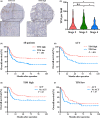High infiltration of mast cells is associated with improved response to adjuvant chemotherapy in gallbladder cancer
- PMID: 31925976
- PMCID: PMC7060478
- DOI: 10.1111/cas.14302
High infiltration of mast cells is associated with improved response to adjuvant chemotherapy in gallbladder cancer
Abstract
Recent studies have reported that tumor-infiltrating mast cells (TIM) play an important role in tumor regression, but the effect of TIM in gallbladder cancer (GBC) remains unclear. The present study aims to investigate the prognostic value of TIM in GBC patients and its responsiveness to gemcitabine-based adjuvant chemotherapy (ACT). A total of 298 GBC patients from Zhongshan Hospital were recruited for this study. TIM infiltration was measured by immunohistochemical staining. Accumulation of TIM is significantly associated with prolonged overall survival in GBC patients. The benefit from gemcitabine-based ACT was superior among patients with high infiltration of TIM with GBC. Multivariate analysis identified TIM infiltration as an independent prognostic factor for overall survival. A heatmap showed that TIM-activated gene signatures were positively correlated with CD8+ T cells' gene signatures. Gene set enrichment analysis (GSEA) suggested that TIM was related to multiple T cell-related processes and signaling pathways, including the interferon gamma signaling pathway and the leukocyte migration signaling pathway. It was confirmed that CD8+ T cell infiltration was positively correlated with high TIM infiltration in tissue microarray (TMA), suggesting that TIM infiltration was linked to the immune surveillance in GBC. TIM can be used as an independent prognostic factor and a predictor of therapeutic response of gemcitabine-based ACT in GBC patients, which may mediate immune surveillance by recruiting and activating CD8+ T cells in GBC.
Keywords: adjuvant chemotherapy; gallbladder cancer; prognosis; tumor immune; tumor-infiltrating mast cells.
© 2020 The Authors. Cancer Science published by John Wiley & Sons Australia, Ltd on behalf of Japanese Cancer Association.
Conflict of interest statement
The authors declare no conflict of interest.
Figures




Similar articles
-
Tumor-infiltrating mast cells predict prognosis and gemcitabine-based adjuvant chemotherapeutic benefit in biliary tract cancer patients.BMC Cancer. 2018 Mar 21;18(1):313. doi: 10.1186/s12885-018-4220-1. BMC Cancer. 2018. PMID: 29562907 Free PMC article.
-
Low expression of equilibrative nucleoside transporter 1 is associated with poor prognosis in chemotherapy-naïve pT2 gallbladder adenocarcinoma patients.Histopathology. 2016 Apr;68(5):722-8. doi: 10.1111/his.12805. Epub 2015 Oct 21. Histopathology. 2016. PMID: 26266900
-
GLI2 but not GLI1/GLI3 plays a central role in the induction of malignant phenotype of gallbladder cancer.Oncol Rep. 2021 Mar;45(3):997-1010. doi: 10.3892/or.2021.7947. Epub 2021 Jan 22. Oncol Rep. 2021. PMID: 33650666 Free PMC article.
-
Updates on Gallbladder Cancer Management.Curr Oncol Rep. 2018 Mar 2;20(2):21. doi: 10.1007/s11912-018-0664-3. Curr Oncol Rep. 2018. PMID: 29500514 Review.
-
[Chemotherapy in gallbladder carcinoma].Presse Med. 2010 Dec;39(12):1238-45. doi: 10.1016/j.lpm.2010.09.002. Epub 2010 Nov 11. Presse Med. 2010. PMID: 21074352 Review. French.
Cited by
-
Taurodeoxycholic acid-YAP1 upregulates OTX1 in promoting gallbladder cancer malignancy through IFITM3-dependent AKT activation.Oncogene. 2023 May;42(18):1466-1477. doi: 10.1038/s41388-023-02660-3. Epub 2023 Mar 16. Oncogene. 2023. PMID: 36928361
-
Ferroptosis-Related Genes Are Potential Therapeutic Targets and the Model of These Genes Influences Overall Survival of NSCLC Patients.Cells. 2022 Jul 15;11(14):2207. doi: 10.3390/cells11142207. Cells. 2022. PMID: 35883650 Free PMC article.
-
Role of mast cell in locally advanced rectal cancer treated with neoadjuvant chemoradiotherapy.BMC Cancer. 2025 Jan 17;25(1):99. doi: 10.1186/s12885-025-13458-9. BMC Cancer. 2025. PMID: 39825280 Free PMC article.
-
Unveiling diagnostic biomarkers and therapeutic targets in lung adenocarcinoma using bioinformatics and experimental validation.Sci Rep. 2025 Jul 2;15(1):22893. doi: 10.1038/s41598-025-05227-2. Sci Rep. 2025. PMID: 40595823 Free PMC article.
-
Increased co-expression of PD1 and TIM3 is associated with poor prognosis and immune microenvironment heterogeneity in gallbladder cancer.J Transl Med. 2023 Oct 12;21(1):717. doi: 10.1186/s12967-023-04589-3. J Transl Med. 2023. PMID: 37828574 Free PMC article.
References
-
- Zeng H, Chen W, Zheng R, et al. Changing cancer survival in China during 2003–15: a pooled analysis of 17 population‐based cancer registries. Lancet Global Health. 2018;6:e555‐e567. - PubMed
-
- Bizama C, Garcia P, Espinoza JA, et al. Targeting specific molecular pathways holds promise for advanced gallbladder cancer therapy. Cancer Treat Rev. 2015;41:222‐234. - PubMed
-
- Wellenstein MD, de Visser KE. Cancer‐cell‐intrinsic mechanisms shaping the tumor immune landscape. Immunity. 2018;48:399‐416. - PubMed
MeSH terms
Substances
Grants and funding
- 81872352/National Natural Science Foundation of China
- 16411952000/Foundation of Shanghai Science and Technology Committee
- SHXH201703/JianFeng project of XuHui Provincial Commission of Health and Family Planning
- 2017ZZ02007/Shanghai Medical Discipline of Key Programs for General Surgery
- 2018ZSLC24/Clinical Study of Zhongshan Hospital
LinkOut - more resources
Full Text Sources
Medical
Research Materials

